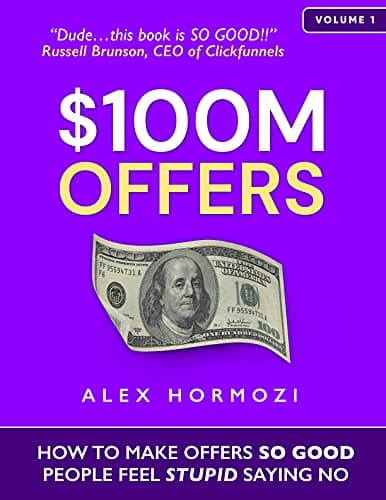$100M Offers - Summary and review

🚀 Summary: $100M Offers in 30 seconds

Contents
There are a gazillion products on the market. You don't want to risk your offer ends up being a commodity. Thus, you need to position yourself differently and create a value offer that stands out.
Why we don't want to compete on price 💰❌
Companies that offer commodities (or what can be viewed as commodities) cannot charge premium prices. Thus, they end up having to compete on price as their only competitive advantage, which leads to price-driven purchases.
This is troubling as it will push margins down and engage in the well-known 'race to the bottom'.
The race to the bottom 📉
Racing to the bottom essentially means relying on cost reductions in operating expenses (OPEX) to stay competitive, grow and survive. This means reducing wages and eventually often quality as well. Typical risks of this race to the bottom involve 1. lost perceived value of your brand, 2. destroyed product innovation, and 3. opening the door for other disruptors.
4 things to look for in a market
In order to sell anything ie. for your offer to work, you need a market. In other words you need demand. But, you don't want to chase or create demand. You want to channel demand.
Here are four components to look for when evaluating markets:
1) Massive pain 🔥
Question to ask: Are prospects in the market suffering ALOT?
Prospects in the market you are after, should not just want your offer, but desperately need it. As Hormozi puts it "The pain is the pitch". Articulate the pain of the prospect accurately - and they will almost always buy. In order to charge money for solving a problem, it must be a painful one - something all these books talk about: SPIN selling, The Mom Test, Way of the Wolf.
2) Purchasing power 💪
Question to ask: Does the targets in the market have money?
For you to be able to make money and build a business from your solution - your audience needs to be able to pay for the solution. Often, this is linked to the size of the problem or perceived pain. But, there are target groups out there that do not have access to the necessary funds, despite them having a big pain in need of being solved.
Make your life easier by targeting a market that can afford your solution and pay premium prices. Think C-level executives vs. students. Both might have a problem taking structured notes, but who's more likely to pay up for your solution?
3) Easy to target 🎯
Question to ask: Is the market easy to target?
You want a market that is easily reachable, ie. with targets or ideal customer profiles that have a lot of common denominators and are easy to find + reach. Your ideal customers could all be subscribed to the same newsletter, listen to the same podcast, hang out on the same network events, be part of the same communities or active in the same social media groups.
It is easy to market to people hanging out in one place. However, if your targets are scattered in 100s different places - then it might be hard getting your offer in front of them.
4) Growth 🚀
Question to ask: Is the market growing?
A growing market means you are working with tailwind and your efforts will gain momentum and speed. Declining markets are like headwind, and make your efforts harder. So, look for markets that grow and will continue to do so.
Three main markets 🤟
According to Hormozi, there are three main markets that always will exist:
health ❤️
wealth 💰
relationships 🥰
The reason these will always exist, is that there is massive pain once you lack these core human needs.
Your goal is to find a subset of one of these larger markets that also show the other three components - ie. the market grows, the target audience has buying power, and the market can easily be targeted.
Ask yourself - what are you good at regarding health, wealth, and releationships? Who is in the biggest pain? Who has money to pay, and who can easily be found?
What's most important? Market, offer strength, or persuasion skills
Order of importance: Market > offer strength > persuasion skills
Pick a bad market, and you have a big problem. A great market means you will make a ton of money, despite your offer being just OK, and you being bad at persuasion.
Being in a normal market with a great offer - you can make money despite being bad at persuasion.
Being in a normal market with a normal offer - means you have to be exeptionally good at persuasion. This is also the most difficult path to follow - since becoming good at persuasion requires a lot of training and effort.
Committing to the choice of market
The way to fail is to keep changing who you market to. Then you will start over from the beginning every time.
Perceived value, pricing and the blind wine test 🍷
Value is subjective. Perceived value is everything. Thus, raising prices increases the value the consumer receives, without changing anything about the product itself. You want your customer to make value-driven purchase decisions, rather than price-driven ones.
When you decrease your price, you also:
Decrease the client's perceived value
Attract the worst clients
Destroy any margin you have left
When you raise your prices, you also:
Increase client's emotional investment
Attract the best clients
Multiply your margin
The blind wine test 🍷
Testing wine without knowing the prices of what you test results in objective answers.
3. The Value Equation and process of crafting a Grand Slam Offer
Value is based on the perception of reality ie. perceived value is everything.
Hormozi recommends to “charge as much money for your products and services as humanly possible”, but never more than they are worth.
In order to create a great offer - one must understand the value of the products and services they deliver. The Value Equation quantifies this value in 4 variables:
The dream outcome (goal ⬆️): “the expression of the feelings and experiences the prospect has envisioned in their mind; the gap between their current reality and their dreams”
Perceived likelihood of achievement (goal ⬆️): the probability that the purchase will achieve the result the prospect is looking for
Time delay (goal ⬇️): “the time between a client buying and receiving the promised benefit” - commonly referred to as “time to value” in PLG
Effort and sacrifice (goal ⬇️): the perceived amount of costs and pain needed to realize the offer
These all have to align to create value. “The Grand Slam Offer only becomes valuable once the prospect perceives the increase in likelihood of achievement, perceives the decrease in time delay, and perceives the decrease in effort and sacrifice.”
Example: Perceived value and London trains 🚆
Problem: The perceived time to commute by train was too slow and people were not happy.
Expensive naive solution: Make trains physically faster and increase the number of trains in rotation.
Cheap out-of-the-box solution: Implement tracking of the trains and display times clearly along the commute. The passengers felt less uncertainty and stress about when to expect the trains. Perceived time waiting and commuting went down, without actually having faster trains. This solution saved billions of dollars.
✍️ My top 3 quotes
These are, in my opinion, the top quotes from the book $100M Offers.
Quote 1
Charge as high a price as you can say out loud without cracking a smile
Quote 2
The degree of the pain will be proportional to the price you will be able to charge
Quote 3
Those who pay the most, pay the most attention
$100M Offers review - what kind of book is it?
Straight-to-the-point value on sales and how to make next-level offers. Delivered with absolute clarity. Nicely condensed a lot of the resources out there, together with Hormozi’s own experience from running multi-million dollar businesses.
Frequently asked questions (FAQs)

Q: Who is Alex Hormozi?
Alex Hormozi, is an American entrepreneur, investor, and philanthropist. By age 32, Alex and his wife Leila’s net worth crossed $100M. As a day job Alex invests and scales companies at Acquisition.com (seeking companies to invest in with $1M in EBITDA). He is the co-owner of the community platform Skool.com.
Want to learn more about growing SaaS companies?

